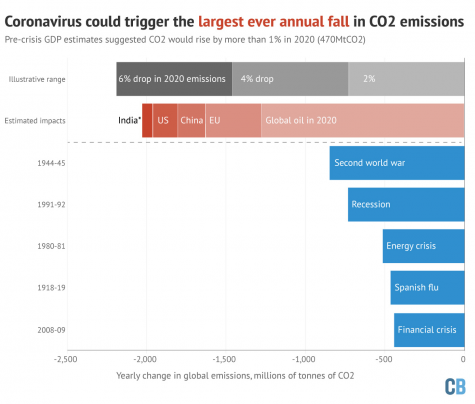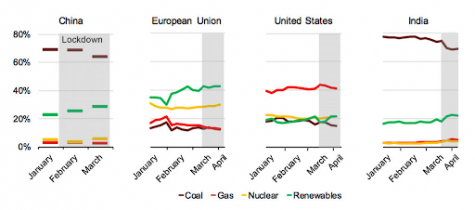Covid-19 Heals the Earth…Temporarily
May 24, 2020
For the past few months most of the world has been silent as people isolate within their homes, public spaces close, and thousands fall victim to the Coronavirus. This once in a lifetime pandemic has placed everyone’s lives on hold. The hustle and bustle in cities such as Manhattan, London, and Tokyo appears to be nothing more than a couple stray citizens testing their luck on the empty streets. Meanwhile, the earth is estimated to catch its biggest break yet since World War 2. Pollution and carbon emissions have drastically decreased as the global economy and travel have been on total lockdown.

Prior to the manifestation of the Covid-19 pandemic, US president Donald Trump eliminated several laws and regulations designed to protect human health and the environment. In late 2019, the New York Times displayed the total numbers of laws Trump had already rolled back, as well as the number of laws in the process of being rolled back. With 95 total rollbacks, 58 completed and 37 in progress, it is evident that Trump is targeting environmental protection laws that he deems too taxing. As the rate of Climate Change is increasing, environmental protection laws all around the globe are more vital than ever. Signs of environmental degradation being cast on the public stage include, the melting of polar ice caps, deforestation, and deterioration of the Great Barrier Reef. These elements of the environment along with many others are necessary to maintain ecological balance, a state of dynamic equilibrium in which the diversity of species and their ecosystems remains relatively stable while still experiencing frequent changes.
Climate Change can be described as a long-term shift in global or regional climate patterns. Currently the world is warming at a faster rate than the environment can adapt to. The process currently accelerating global warming and climate change is defined as the “greenhouse effect”. The term could be described earliest by American scientist Eunice Foot, who due to her being a female was not given credit for her contributions. The “greenhouse effect” occurs when the earth’s gases trap excess heat and keep it within the earth’s atmosphere instead of releasing it into space. Gases such as Carbon Dioxide, Methane, Ozone, Nitrous Oxide, Chlorofluorocarbons, and water vapor allow for the sun’s rays to enter the earth, but prevent the heat from leaving in a complex heat exchange process. Without this trapping ability, Earth would be too cold to sustain life and the same would happen with too much heat. Carbon Dioxide, however, presents the most damaging effects. This is because it remains in the atmosphere far longer than the other gases. When released into the air, 40% of CO2 remains in the atmosphere for 100 years, 20% will remain for 1,000 years, and 10% will remain for a whole 10,000 years. Deforestation releases the carbon dioxide previously stored within plants and soil and adds it into the atmosphere. The burning of fossil fuels releases carbon and oxygen into the air, causing them to combine to form large amounts of carbon dioxide. We burn fossil fuels to produce heat, electricity, and facilitate transportation, all things playing a vital role in the economy. Greenhouse gas emissions rise and fall annually depending on economic status, fuel consumption, energy use, and multiple other factors.
Covid-19 has taken siege of economies and governments worldwide, causing pollution and carbon emissions to sharply decline. In a time where health means more than wealth, the earth is given a break. How long will this last? Not long, according to experts claiming that unless the pandemic has brought newfound attention towards decreasing emissions and moving towards cleaner energy, there will be a quick rebound. Globally, carbon emissions are estimated to drop 8%. That 8% drop is within the range needed to limit global warming annually to 1.5C above temperatures recorded prior to industrialization. This number of 1.5C represents the safest limit in terms of yearly global temperature increase to avoid the “worst impacts” of global warming. CO2 is estimated to fall to an annual emissions total of 30.6bn tonnes compared to last year’s 33.3bn tonnes. A decline in coal use has proved to be one of the largest factors of this decrease. In China, carbon emissions fell 25% in a four-week period and lowered to 18% in a 7-week period following. Analysts claim that if economic demand recovers, these numbers won’t play a significant enough impact on the global percentage, as emissions will likely sky-rocket back to prior rates. As the cases in China have decreased, the economy is attempting to restart and return to normal.

“By the end of March, energy usage, pollution levels, and carbon emissions all seemed to be on the rebound”, according to National Geographic, Madeline Stones article on the CREA’s Carbon Brief analysis. Countries like China have overpopulation and large industries in which their industrial emission outputs are likely to return to normal once demand and large-scale projects in the public sector opens up, purely due to necessity. On the opposite end, if demand is reduced likely due to low job prospects, then these outputs may not return back to normal. Which could mean an effective decrease in total emissions, but could also mean a major economic crisis.
Europe and several other countries are shown to have begun turning to cleaner energy. In Europe on April 29th CO2 emissions from the gas and electricity sector were 39% lower over the past 30 days than the exact time in 2019. In those 30 days, data also showed that solar power usage rose by 28% compared to the previous year. Renewable energy sources such as wind and solar power have risen tremendously in several European countries in the past few months. Renewable energy has proved useful during this time of economic struggle. There are little to no dependencies on global sectors to operate these sources of energy. Good weather and sunny skies prove to get the job done. Throughout Europe, electricity has seen a decreased demand and reliability. Power plants are unable to shut down when there are low to negative market prices.
Globally, records indicate that in the past few months renewable energy shares have reached hourly highs. In countries, Belgium, Germany, Italy, Hungary, and the US solar and wind power usage has risen above previous counts. Shown in the graphs below, coal, natural gas, and nuclear energies have remained steady or even decreased in the world’s leading countries. Renewable energy sources are projected to be the only sources to grow this year.
Rising prospects for increased use of renewable energy could mean a long-term deficit in carbon emissions released, but this will depend on how the world responds once the pandemic has reached its estimated decline. Based on the data presented it appears that it could go two ways; consumer demand could return to its towering position or increased global attention could be paid to the mass environmental effects of this pandemic-induced economic shut-down. Either way, this pandemic has allowed for cleaner energy sources to prove their worth as well as for the detriments of carbon emissions and pollution to clear the way for change. The future of climate change and global warming lies in the hands of global leaders and will rely on the action of the population.
Works Cited
“Deforestation and Forest Degradation.” WWF, World Wildlife Fund, www.worldwildlife.org/threats/deforestation-and-forest-degradation. Accessed 23 May 2020.
Evans, Simon. “Analysis: Coronavirus Set to Cause Largest Ever Annual Fall in CO2 Emissions.” Carbon Brief, 7 May 2020, www.carbonbrief.org/analysis-coronavirus-set-to-cause-largest-ever-annual-fall-in-co2-emissions. Accessed 23 May 2020.
Gabbatiss, Josh. “IEA: Coronavirus Impact on CO2 Emissions Six Times Larger than 2008 Financial Crisis.” Carbon Brief, 1 May 2020, www.carbonbrief.org/iea-coronavirus-impact-on-co2-emissions-six-times-larger-than-financial-crisis. Accessed 23 May 2020.
Glick, Daniel. “Global Climate Change, Melting Glaciers.” Global Climate Change, Melting Glaciers, 18 Jan. 2017, www.nationalgeographic.com/environment/global-warming/big-thaw/. Accessed 23 May 2020.
“Global CO2 Emissions in 2019 – Analysis.” IEA, 11 Feb. 2020, www.iea.org/articles/global-co2-emissions-in-2019. Accessed 23 May 2020.
Jones, Dave. “Analysis: Coronavirus Has Cut CO2 from Europe’s Electricity System by 39%.” Carbon Brief, 1 May 2020, www.carbonbrief.org/analysis-coronavirus-has-cut-co2-from-europes-electricity-system-by-39-per-cent. Accessed 23 May 2020.
McNeill, Leila. “This Lady Scientist Defined the Greenhouse Effect But Didn’t Get the Credit, Because Sexism.” Smithsonian.com, Smithsonian Institution, 5 Dec. 2016, www.smithsonianmag.com/science-nature/lady-scientist-helped-revolutionize-climate-science-didnt-get-credit-180961291/. Accessed 23 May 2020.
Morrison, Tiffany, and Terry Hughes. Climate Change and the Great Barrier Reef. James Cook University, NCCARF, 2016, www.nccarf.edu.au/sites/default/files/attached_files/GBR_PIB_WEB.pdf. Accessed 23 May 2020.
Myllyvirta, Lauri. “Analysis: Coronavirus Temporarily Reduced China’s CO2 Emissions by a Quarter.” Carbon Brief, 1 May 2020, www.carbonbrief.org/analysis-coronavirus-has-temporarily-reduced-chinas-co2-emissions-by-a-quarter?utm_content=bufferae67b. Accessed 23 May 2020.
NASA Climate Kids. “What Is the Greenhouse Effect?” NASA, https://climatekids.nasa.gov/greenhouse-effect/. Accessed 23 May 2020.
National Geographic Resource Library “Climate Change.” National Geographic Society, 27 Mar. 2019, www.nationalgeographic.org/encyclopedia/climate-change/. Accessed 23 May 2020.
Popovich, Nadja, et al. “The Trump Administration Is Reversing 100 Environmental Rules. Here’s the Full List.” The New York Times, The New York Times, 2 June 2019, www.nytimes.com/interactive/2020/climate/trump-environment-rollbacks.html?mtrref=undefined. Accessed 23 May 2020.
Shen, Qilai. “Carbon Emissions Are Falling Sharply Due to Coronavirus. But Not for Long.” National Geographic, 8 May 2020, www.nationalgeographic.com/science/2020/04/coronavirus-causing-carbon-emissions-to-fall-but-not-for-long/. Accessed 23 May 2020.
“Sources of Greenhouse Gas Emissions.” EPA, Environmental Protection Agency, 11 Apr. 2020, www.epa.gov/ghgemissions/sources-greenhouse-gas-emissions. Accessed 23 May 2020.
“Why Does CO2 Get Most of the Attention When There Are so Many Other Heat-Trapping Gases?” Union of Concerned Scientists, 3 Aug. 2017, www.ucsusa.org/resources/why-does-co2-get-more-attention-other-gases. Accessed 23 May 2020.
